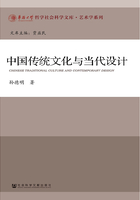
Abstract
Design is not only a commercial behavior or a way to provide social services, but also a wide-ranging cultural creation or a way of cultural inheritance. This book aims to explore the combination of contemporary design and traditional culture from the macro cultural perspective.
There would always be a stirring of interest in traditional culture studies when culture shock occurred in China since the late Qing Dynasty. This, of course, is a good phenomenon, and will help to reflect the certain cultural situation of China. However, at present, the surge of research into Chinese traditional culture is mingled with some impetuous factors. So this book is striving to help the designers to deepen their understanding of traditional culture of China, and improve their abilities of using the traditional cultural symbol.
As we know that human being is a complex of the natural attribute and the societal attribute. Neither the material nor the spirit is dispensable in the existence and development of human being. Though there have been many classic exposition of above topic for centuries, it is necessary to summarize the experiences of predecessors, and to form value conception systematically. We all know that life will become unsustainable without the gene heredity and mutation. As an analogy, culture will not be able to develop without inheritance and innovation. There are several essential relationships such as the relation between nature and society, or matter and spirit, is always the key in the field of design at all times and in all countries. This book sets out to explore the spirit value of Chinese traditional culture, and try to find a way of combining the traditional design and contemporary design.
Chinese contemporary design was the result of the western modern design education and developed in the domestic and foreign market economy environment which also developed rapidly with the progress of science and technology. But the present environment of Chinese design is filled with a variety of adverse factors, such as the opportunism and the money worship, and sometimes the traditional culture is only a cover. As a matter of fact, the abuse of traditional culture in contemporary design has caused irreparable damage to the society. In order to make order out of confusion, it is necessary to return to the basic level of design and traditional culture of China, explore the essence of traditional cultureand serve contemporary design. As we know that contemporary design can serve people and educate the public, what is more, it also help to uphold the ethics and morals, social order specifications, especially to attack the scientific chauvinism and cultural nihilism. On the other side, contemporary design theory mainly focuses on how to satisfy the user's requirements, seek marketing opportunities, boost economic development, decrease the cost of production, optimize work structure, protect the environment, and so on. It seems that traditional culture is just a symbol more than a construction of human environment. So, in my opinion, theoretical research of the design should jump out of the restriction of fine arts, technology and economic, and explore the cultural value of design from philosophy, literature, history, education and so on.
This book is made up of three parts: epistemology, methodology, and design case. Chapter one consists of the first four chapters, from chapter five to chapter six is the part of methodology, and design case consists of chapter seven to the end. There may be some cross relations among different parts of this book. As too many aspects of traditional culture were concerned, some contents were simplified to make a more reasonable book structure. The overall language style of this book is popular and easy to understand. Also, many colorful illustrations were integrated to rich the content. So that, this book will be useful not only for designers but also for people who love traditional Chinese design culture.
Although many design theories have paid attention to the traditional culture at present, there is still much considerable research space. Firstly, the research on traditional culture needs to be strengthened. For example, the history of arts and crafts and graphic design should be reexamined from the perspective that design can produce civilization. Further more, the study on traditional design culture shouldn't limit to objects, a great amount of literatures also contain many useful ideas of design, just as the words of Chairman Xi: “Through reading and studying the excellent traditional books, we can learn from the wisdom and experience in the field of self-cultivation or state control of the predecessors, cultivate the magnanimous gestures and noble character, and improve the humanistic quality and mental state continuously.” Laden with heavy responsibility of setting up harmonious society, we should enrich ourselves through studying traditional culture first, and then to help others. Secondly, design theory is not easy to be combined with practice because people are always not able to relate design theory with practice, and the excuse is often the pressure from the design environment. This book aims to solve the problems above through the analysis of classic design cases. All the same, this book is mainly an introduction to traditional culture and contemporary design, So there are still a lot to do in dealing with some specific questions.